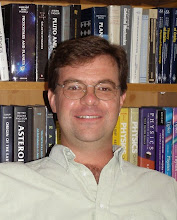 C. Lovis and colleagues at the European Southern Observatory in Chile used the 3.6m telescope there to discover 5 or more planets orbiting the star HD 10180. The five certain planets are all Neptune-class, having masses of 12-25 times that of Earth. Also, all orbit rather close to the star, at distances of 0.06-1.4 AU. There is also tentative evidence for an Earth-mass planet orbiting at r=0.02 AU, and a possible 3-Neptune-mass planet orbiting at r=3.4 AU. Ellipses in the above figure show the planets current orbits, while the colored regions indicate their range of motions over time that are due to their mutual gravities. As the figure shows, this system is quite dense with planets, which is actually rather typical for multi-planets extra-solar planetary systems. See the preprint for more details.
C. Lovis and colleagues at the European Southern Observatory in Chile used the 3.6m telescope there to discover 5 or more planets orbiting the star HD 10180. The five certain planets are all Neptune-class, having masses of 12-25 times that of Earth. Also, all orbit rather close to the star, at distances of 0.06-1.4 AU. There is also tentative evidence for an Earth-mass planet orbiting at r=0.02 AU, and a possible 3-Neptune-mass planet orbiting at r=3.4 AU. Ellipses in the above figure show the planets current orbits, while the colored regions indicate their range of motions over time that are due to their mutual gravities. As the figure shows, this system is quite dense with planets, which is actually rather typical for multi-planets extra-solar planetary systems. See the preprint for more details.
Friday, November 26, 2010
A densely packed planetary system at HD 10180
 C. Lovis and colleagues at the European Southern Observatory in Chile used the 3.6m telescope there to discover 5 or more planets orbiting the star HD 10180. The five certain planets are all Neptune-class, having masses of 12-25 times that of Earth. Also, all orbit rather close to the star, at distances of 0.06-1.4 AU. There is also tentative evidence for an Earth-mass planet orbiting at r=0.02 AU, and a possible 3-Neptune-mass planet orbiting at r=3.4 AU. Ellipses in the above figure show the planets current orbits, while the colored regions indicate their range of motions over time that are due to their mutual gravities. As the figure shows, this system is quite dense with planets, which is actually rather typical for multi-planets extra-solar planetary systems. See the preprint for more details.
C. Lovis and colleagues at the European Southern Observatory in Chile used the 3.6m telescope there to discover 5 or more planets orbiting the star HD 10180. The five certain planets are all Neptune-class, having masses of 12-25 times that of Earth. Also, all orbit rather close to the star, at distances of 0.06-1.4 AU. There is also tentative evidence for an Earth-mass planet orbiting at r=0.02 AU, and a possible 3-Neptune-mass planet orbiting at r=3.4 AU. Ellipses in the above figure show the planets current orbits, while the colored regions indicate their range of motions over time that are due to their mutual gravities. As the figure shows, this system is quite dense with planets, which is actually rather typical for multi-planets extra-solar planetary systems. See the preprint for more details.
Subscribe to:
Post Comments (Atom)

3 comments:
Encontrar vida em outros sistemas é mera questão de tempo. Há 15 anos sequer sabíamos se existiam planetas orbitando outras estrelas, e hoje já são quase 500 planetas descobertos (veja meu post sobre o assunto: http://hipernovas.blogspot.com/2010/10/do-genesis-atualidade-modelo-muito.html), e esse número só cresce. A ciência está agora empenhada em descobrir planetas ou luas de planetas gigantes de dimensões parecidas com a nossa Terra, onde as probabilidades de surgimento de vida sejam maiores. Estamos na expectativa do lançamento de missões como James Webb Telescope (que substituirá o Hubble), OWL - Um projeto de telescópio com espelho de 100 metros que depois de pronto resolverá até detalhes na superfície de planetas extrassolares, e esperar pelos resultados do satélite Kepler, cujo principal objetivo é encontrar outras Terras.
Ótimo blog. Continue divulgando o conhecimento. Abraços!
Eu concordo. Obrigado!
I wish to make a comment, there is coming one day discovery of an earth like Planet and then they will find trillions of such planets, this might start with the coming james T Webb space based telescope to replace the Hubble by 201 with Nasa
Post a Comment